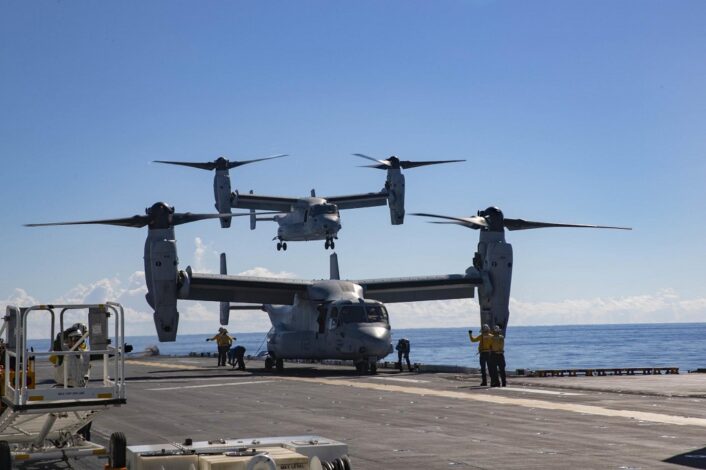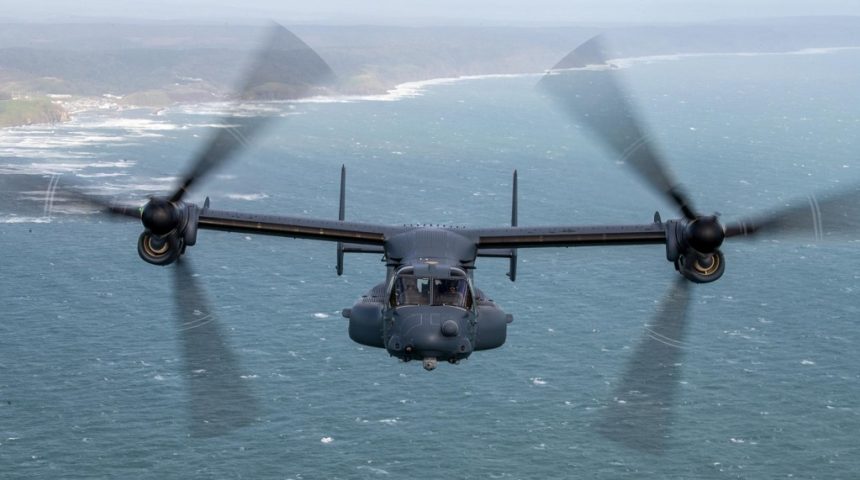The fix will solve the issue in the short term, while the faulty component is redesigned for a long-term solution.
The U.S. military recently issued a new flight restriction for the V-22 Osprey, grounding an undisclosed number of tiltrotors in an effort to fix the hard clutch engagement issue that was behind the other flight restriction issued last year. The decision follows a recommendation from the Pentagon’s V-22 Joint Programme Office based on a “progressive increase in hard clutch engagement events and ongoing engineering analysis”.
Hard clutch engagement occurs when the clutch connecting the propeller’s gear box to its engine slips and the Osprey transfers the power load from that engine to the other one, allowing it to keep flying in the event of an engine failure, and then the power load in transferred back to the original engine as its clutch engages again. The large transfer of torque between the two engines within a span of milliseconds sends an impulse through the drive train, which can potentially damage the system and throws the aircraft off balance.
Apparently, the source of the problem resides in the Input Quill Assembly (IQA), the assembly that links the engine to the gearbox and which also houses the clutch. In fact, after extended data analysis, the V-22 JPO found a clear connection between the IQA’s flight time and the probability of a hard clutch engagement and therefore issued a time limit for the IQA.
“This recommendation is based on a progressive increase in hard clutch engagements and ongoing engineering analysis,” said an official to reporters. “The fleet bulletin identifies aircraft with input quill assemblies above a predetermined flight hour threshold and the requirement to replace that component. Once replaced, aircraft will return to flight status.”
The replacement will be performed at squadron level, as the new parts are already in the supply system and squadrons’ maintenance crews have tools, manuals and expertise to do the repair work themselves. The new IQAs are expected to last for years, before needing another replacement. In the meanwhile, the JPO and Boeing are performing lab and flight tests of the component to better understand the hard clutch engagement, as well as working on a redesign of the assembly for a longer-term solution.

As the repairs are underway, Marine Corps, Navy and Air Force Special Operations Command units will continue training and operations with aircraft whose IQA has not yet reached the time limit. It is not known how many Ospreys are available for operations at this time, as officials only said a subset of aircraft is affected by the flight restriction, without providing further details. Also, the Navy reportedly did not experience hard clutch engagements so far.
After a hard clutch engagement left a CV-22 stranded in Norway for six weeks in 2022, the Air Force grounded its Ospreys to ensure airmen’s safety. A mechanical solution was not available when the grounding was lifted two and a half weeks later, so the service, as a temporary measure until a permanent solution is identified, modified the guidelines for aircrew to avoid situations likely to cause hard clutch engagement and added the scenario to simulator training syllabus.
The aircrews are required to land immediately after experiencing a hard clutch engagement. These issues have often led to the replacement of Ospreys’ gear boxes and engines, qualifying these incidents as a Class A mishap, costing more than $ 2.5 million each. None of these mishaps, however, were fatal and aircrews always walked away without injuries. The latest of such incidents reportedly happened very recently, during the last weekend of January 2023.









